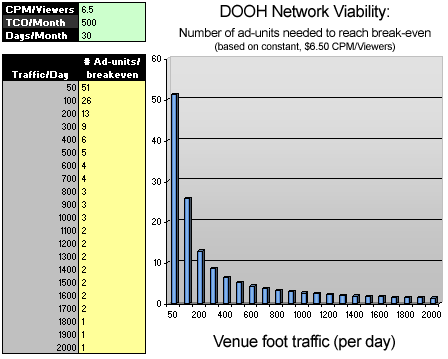What does it take to fund a 100-screen network?
First, the usual caveats apply. As we always note in our digital signage budgeting articles, there's really no such thing as a typical digital signage network, whether it's 10, 100 or 1,000 screens. And the variable costs of things like content, venue profit sharing and the like can considerably affect what it truly costs to own and operate a network. Still, there's no denying that regardless of size, it has consistently gotten less expensive to build out a network over the years. That's why it's so befuddling to find so many DOOH networks continually starting up and shutting down. I mean, if the enabling technology keeps getting more affordable, and there are all these experts and Internet sites out there to warn people about common pitfalls and explain how to pick business models and optimize content performance, why aren't more networks surviving?
Well, if the results of our DOOH pricing survey are accurate, a big part of the problem may simply be picking a pricing system that both the buyer and seller are comfortable with. As we learned, most buyers and sellers want to base pricing on some kind of reach-based metric like CPM Viewers. However, when asked how they tend to buy/sell DOOH ads, only 28.6% indicated that they currently use this approach, while 24% buy or sell on a spot-by-spot basis, and 22.1% buy or sell on a screen-by-screen (or venue-by-venue) basis.
We also learned that the median CPM Viewers price of $6.50 might be representative of what's being bought/sold in today's market, but a single number can't really capture the wide variety of networks and media prices that are out there. Consequently, buyers and sellers alike have trouble making meaningful price comparisons and can't mentally shop a DOOH sale or purchase against other kinds of media.
Let's talk numbers
We noted last year that the "average" 100-screen network takes an average of 9 people to run, with an average salary of $52.5K per employee. That's equivalent to $39,375/month in expenses, or $394/screen/month. When added to the $103/screen/month in capital expenses we calculated from our survey results, the "average" screen in a "typical" 100-screen network costs about $497/month after salaries are factored in. In other words, a 100-screen network would need to earn just under $50,000/month to stay afloat.
Regardless of how you choose to price it, the figures above indicate that each screen in the network needs to earn about $500/month. Using CPM Viewers-based pricing and our median figure of $6.50 CPM, we can thus calculate a wide range of break-even scenarios (assuming that ad buyers are buying on a month-to-month basis, there are 30 days in a month, and each viewer sees every ad once during their visit):

By combining this information with a basic knowledge of venue traffic profiles, we can get a better understanding of how the break-even analysis plays out in real world scenarios:
- For a network in low-traffic venues that sees only 1,000 visitors/venue/month, you'd need to sell a whopping 77 units of ad time on each screen to break even. If those are all 15-second spots, that amounts to over 19 minutes of commercial air time (double if the spots are 30 seconds long).
- Moderate traffic venues like retail stores and specialty markets might serve 150 customers each day, or around 4,500 per month. Screens in these locations would need to sell about 17 units of ad time to break even.
- Meanwhile, a reasonably high-traffic QSR location might serve 1,500 customers a day. A network built in these types of venues would only have to sell about 2 units of ad time on each screen to break even, since each ad would be shown to about 45,000 people/month.
- Finally, a high traffic venue like a popular supermarket can easily serve over 2,500 customers per day. Assuming that all of them came across the DOOH network's screen, that owner would only have to sell one ad-unit of time to break even. Of course, at these high volume locations, ad buyers may be less comfortable paying the full CPM price, especially in situations where it's unlikely that all customers will actually see the screen.
While CPM Viewers pricing clearly works out favorably for the seller at high-volume locations, there are tens of thousands of screens deployed in venues that don't get anywhere near the several hundred visitors per day needed to make the model affordable. For these networks, a flat price-per-spot-per-month model probably makes more sense. Looking back at our DOOH survey data on the matter, clients reported being willing to pay anywhere from under $20 to more than $140/spot/screen/month, presumably depending on factors like the desirability of the location, screen size, etc. Still, the math here is easy: at $20/spot/month, a network owner would need to sell about 25 spots/screen/month to break even. At a whopping $140/spot/screen/month, he would need to sell less than 4.
Of course, most network owners aren't aiming for a break-even scenario. They want to be profitable. And as you can see from the numbers above, the different pricing strategies can have a pretty significant impact on what it takes to reach profitability. They also differ on things like promotional techniques: "giving away" a $140 spot to a good customer is obviously less desirable than giving away a $20 one (even though the cost basis is probably the same: close to zero). And lowering the CPM for a "bonus" ad might cause a client to question why the CPM would be "higher" for all of his fully-paid spots.
Still, there's plenty of creativity in the industry when it comes to pricing ads on digital signage networks, and I'm pleased to see that the above combination of our two survey data sets doesn't fall far from my own observations, and the comments I've received from our customers. This makes me particularly excited about our upcoming 2011/2012 digital signage pricing survey. I don't get the feeling that costs have changed that much since our last survey, but I've been wrong about that kind of thing before. And later in the year, we'll be following up with another survey on content generation, in order to get a more complete picture of what it takes to build and run a network of digital signs, whether for advertising or other purposes.
Do these break-even estimates match up with your expectations? Leave a comment and let us know! (If you're viewing this in your email or RSS reader, click through to /blog to comment.)


 Subscribe to the Digital Signage Insider RSS feed
Subscribe to the Digital Signage Insider RSS feed
Comments
for 1,000 visitors/venue/month, you need 77 units ? the formula ....:)
As I noted, though, for small indoor signage networks (less than 1,000 venues at least) it is uncommon to sell on a CPM basis. Most advertisers and network owners alike agree that a monthly/quarterly per-screen fee is more appropriate.
Thanks
I have a question–
I am an employee at a small prom and bridal shop, and we are looking to utilize digital signage by selling advertising time (targeting limo companies, florists, and other complementary industries) on a TV in our waiting room. We have about 4,000 visitors/ month who typically wait anywhere from 10 minutes – an hour in our waiting room (where our TV is hung). We have a software that we can use to create ads/upload provided ads (costing $30/month) and are thinking about running a continuous loop of advertisements (15 – 30 seconds each) about 50-70 times/day.
I am struggling with drafting up a price model for advertising time. We are leaning towards a flat-rate model, but have been unable to find substantial data indicating what a fair market price would be for the service. Could you recommend a price or model we can use?
I find it helpful to set some lower and upper bounds when making a pricing model. For example, the average CPM (cost per thousand views) for a billboard is about $5. So, at 4,000 viewers a month, a lower bound would be $20 per month per ad -- pretty low. Setting an upper limit is harder, but it may be helpful to think about your advertisers and the amount of money they stand to make if you convert a viewer into a customer for them. For example, the profit on a wedding day limo ride might be $200, so perhaps that would be your upper limit. From there you'd have to experiment and pick a flat-rate pricing scheme that works. Anecdotally, I've seen networks similar to yours offering monthly 15- or 30-second spots in a 5-7 minute rotation for between $100 and $150 per month, usually with a decent discount (30% is not uncommon) for an annual buy.
I fail to see how your average 100 screen networks require 9 people to run. Do they manually go by each screen to update them?
If you have a well designed system with integrated software and hardware, a 200 screen network should require no more than 5 people including sales and administrative support.
Additionally, the hardware costs quoted are out of this world. If digital signage companies truly spend that amount of money (or is that what they charge the end customer?) then they will all be out of business when smaller, much nimbler competitors come along.
First off, this article is several years old, so things have certainly changed for the better. But even at the time of writing, most of the overhead was tied up in content creation and sales -- administering the network takes little physical effort. But making sure it's stocked with content (especially if it's revenue-generating content) still takes work.
In order to fully cover the bus network a total of 154 screens would need to be installed. Now the average time spent on a bus ride will be 10 minutes. So assuming 15 second slots that would give a total of 680 million possible impressions.
But i'm not sure if i'm doing the math wrong. In your article your only accounting for one impression per person that is walking into the store, correct? So in my case would I not need to be as concerned about how many people are actually getting onto the bus network since they will be on the bus ride for atleast 10 minutes?
RSS feed for comments to this post